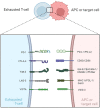Focus on T cell exhaustion: new advances in traditional Chinese medicine in infection and cancer
- PMID: 37355637
- PMCID: PMC10290330
- DOI: 10.1186/s13020-023-00785-x
Focus on T cell exhaustion: new advances in traditional Chinese medicine in infection and cancer
Abstract
In chronic infections and cancers, T lymphocytes (T cells) are exposed to persistent antigen or inflammatory signals. The condition is often associated with a decline in T-cell function: a state called "exhaustion". T cell exhaustion is a state of T cell dysfunction characterized by increased expression of a series of inhibitory receptors (IRs), decreased effector function, and decreased cytokine secretion, accompanied by transcriptional and epigenetic changes and metabolic defects. The rise of immunotherapy, particularly the use of immune checkpoint inhibitors (ICIs), has dramatically changed the clinical treatment paradigm for patients. However, its low response rate, single target and high immunotoxicity limit its clinical application. The multiple immunomodulatory potential of traditional Chinese medicine (TCM) provides a new direction for improving the treatment of T cell exhaustion. Here, we review recent advances that have provided a clearer molecular understanding of T cell exhaustion, revealing the characteristics and causes of T cell exhaustion in persistent infections and cancers. In addition, this paper summarizes recent advances in improving T cell exhaustion in infectious diseases and cancer with the aim of providing a comprehensive and valuable source of information on TCM as an experimental study and their role in collaboration with ICIs therapy.
Keywords: Cancer; Immune checkpoint inhibitors; Infection; T cell exhaustion; Traditional Chinese medicine.
© 2023. The Author(s).
Conflict of interest statement
The authors declare that they have no competing interests.
Figures



Similar articles
-
Coinhibitory Receptor Expression and Immune Checkpoint Blockade: Maintaining a Balance in CD8+ T Cell Responses to Chronic Viral Infections and Cancer.Front Immunol. 2017 Sep 29;8:1215. doi: 10.3389/fimmu.2017.01215. eCollection 2017. Front Immunol. 2017. PMID: 29033936 Free PMC article. Review.
-
Clinical implications of T cell exhaustion for cancer immunotherapy.Nat Rev Clin Oncol. 2022 Dec;19(12):775-790. doi: 10.1038/s41571-022-00689-z. Epub 2022 Oct 10. Nat Rev Clin Oncol. 2022. PMID: 36216928 Free PMC article. Review.
-
Memory T cell, exhaustion, and tumor immunity.Immunol Med. 2020 Mar;43(1):1-9. doi: 10.1080/25785826.2019.1698261. Epub 2019 Dec 10. Immunol Med. 2020. PMID: 31822213 Review.
-
Schrödinger's T Cells: Molecular Insights Into Stemness and Exhaustion.Front Immunol. 2021 Aug 26;12:725618. doi: 10.3389/fimmu.2021.725618. eCollection 2021. Front Immunol. 2021. PMID: 34512656 Free PMC article. Review.
-
Exhausted CD8+T Cells in the Tumor Immune Microenvironment: New Pathways to Therapy.Front Immunol. 2021 Feb 2;11:622509. doi: 10.3389/fimmu.2020.622509. eCollection 2020. Front Immunol. 2021. PMID: 33633741 Free PMC article. Review.
Cited by
-
A Comprehensive Comparison between Primary Liver Cancer and Liver Metastases through scRNA-Seq Data Analysis.Metabolites. 2024 Jan 26;14(2):90. doi: 10.3390/metabo14020090. Metabolites. 2024. PMID: 38392982 Free PMC article.
-
Bibliometric analysis of traditional Chinese medicine in cancer treatment via immune system modulation (2015-2025).Front Immunol. 2025 May 8;16:1581885. doi: 10.3389/fimmu.2025.1581885. eCollection 2025. Front Immunol. 2025. PMID: 40406101 Free PMC article.
-
Dysfunction and regulatory interplay of T and B cells in chronic hepatitis B: immunotherapy and emerging antiviral strategies.Front Cell Infect Microbiol. 2024 Dec 9;14:1488527. doi: 10.3389/fcimb.2024.1488527. eCollection 2024. Front Cell Infect Microbiol. 2024. PMID: 39717542 Free PMC article. Review.
-
MicroRNA changes with macro potential contribute to secondary immunodeficiency in chronic lymphocytic leukemia during epstein barr virus reactivation.Sci Rep. 2025 May 12;15(1):16446. doi: 10.1038/s41598-025-01572-4. Sci Rep. 2025. PMID: 40355604 Free PMC article.
References
-
- Gallimore A, Glithero A, Godkin A, Tissot AC, Plückthun A, Elliott T, et al. Induction and exhaustion of lymphocytic choriomeningitis virus-specific cytotoxic T lymphocytes visualized using soluble tetrameric major histocompatibility complex class I-peptide complexes. J Exp Med. 1998;187(9):1383–1393. doi: 10.1084/jem.187.9.1383. - DOI - PMC - PubMed
Publication types
Grants and funding
- 2021XYCZ004/Sichuan Provincial Administration of Traditional Chinese Medicine Major science and technology projects
- 81973840/National Natural Science Foundation of China
- 81273748/National Natural Science Foundation of China
- 2018ZX10303502/National science and Technology major projects of the 13th Five-Year Plan
- 223777156D/Science and Technology Program of Hebei
LinkOut - more resources
Full Text Sources

